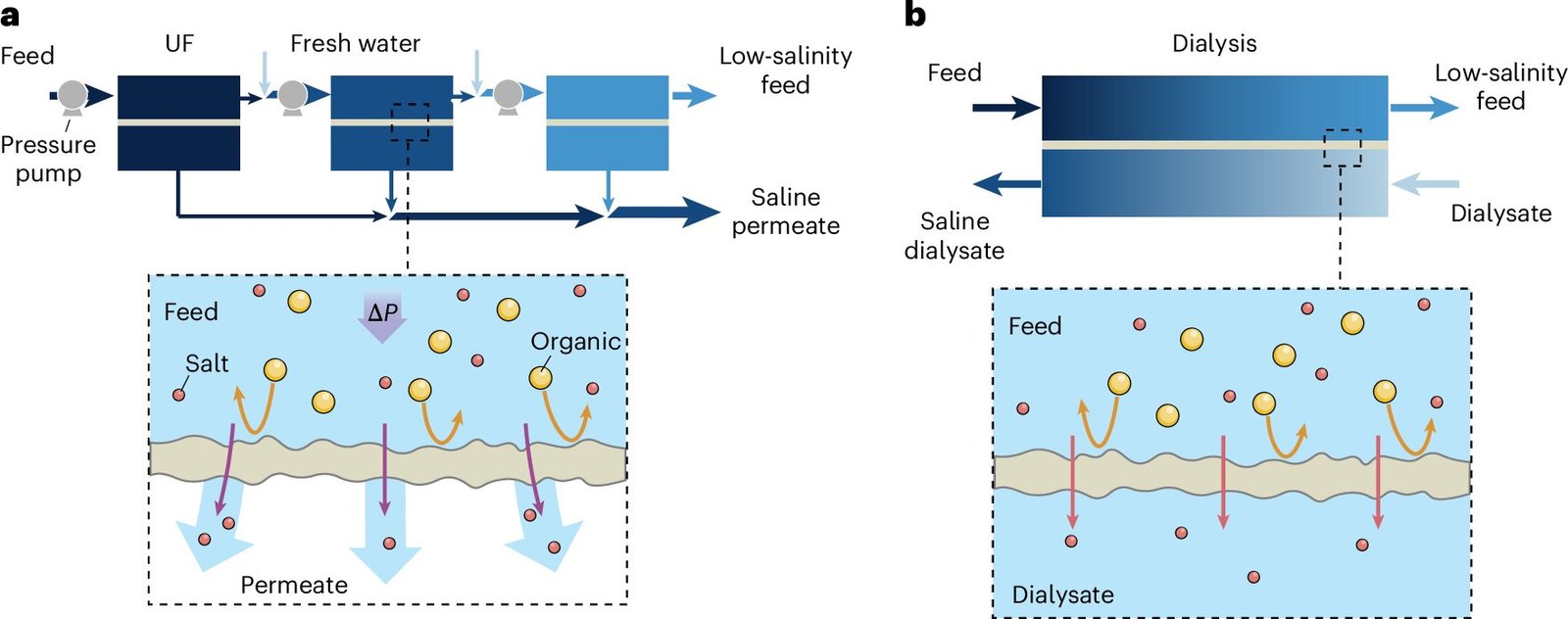Researchers at Rice University, in collaboration with Guangdong University of Technology, have developed an innovative solution for treating high-salinity organic wastewaters—wastewater streams that contain elevated levels of both salts and organic materials. This groundbreaking approach borrows a well-known technique from the medical field: dialysis, which is traditionally used to treat kidney failure patients by filtering waste and excess fluid from the blood.
In dialysis, a machine called a dialyzer draws blood from the body, cleanses it by passing it through a filter, and then returns the purified blood. This principle has now been adapted to treat wastewater, providing an elegant solution to the growing environmental and operational challenges posed by high-salinity organic waste. In their study published in Nature Water, the research team found that applying dialysis in wastewater treatment could effectively separate salts from organic compounds, doing so with minimal dilution of the wastewater. This approach not only addresses the shortcomings of conventional wastewater treatment methods but also offers significant benefits in terms of environmental impact, cost reduction, and resource recovery.
Menachem Elimelech, a professor at Rice University and one of the corresponding authors of the study, explained that dialysis was unexpectedly effective in separating salts from organic compounds in the trials. He expressed excitement about the discovery, emphasizing the potential of this new method to revolutionize how industries handle wastewater that has been notoriously difficult to treat. The innovation promises a solution to some of the most persistent wastewater management problems faced by industries today.
High-salinity organic wastewater is generated by several industries, including petrochemical, pharmaceutical, and textile manufacturing. These wastewaters are especially challenging to treat due to their combination of high salt and organic content. Traditional treatment methods, such as biological treatment and advanced oxidation, often fail or become less effective when confronted with elevated salinity levels. Biological treatment, in particular, relies on microorganisms to break down organic material, but high salinity can inhibit microbial activity, reducing efficiency. Similarly, advanced oxidation methods, which use chemical processes to decompose pollutants, can be compromised by high salt concentrations, rendering them ineffective.
Thermal methods, though technically feasible, have their own set of challenges. They are energy-intensive and prone to issues such as corrosion, clogging, and operational inefficiencies. These problems not only increase operational costs but also require extensive maintenance. Membrane-based filtration methods, such as ultrafiltration, are frequently used, but they are not without drawbacks. Membrane fouling—where substances accumulate on the surface of the membrane—can severely degrade performance, requiring repeated cleaning and additional water dilution, which increases both water consumption and operational complexity.
Yuanmiaoliang “Selina” Chen, a co-first author of the study and a postdoctoral student in Elimelech’s lab, explained that dialysis provides a distinct advantage by eliminating many of these common problems. Unlike traditional methods, dialysis does not require high energy inputs or repeated dilutions. This makes it a more sustainable and cost-effective solution for treating high-salinity organic wastewater.
The research team carried out a series of bench-scale dialysis experiments and developed detailed transport models to evaluate the performance of dialysis in separating salts from organic compounds. The researchers first selected commercial ultrafiltration membranes with different molecular weight cutoffs to study how salts and organic compounds were transported across the membrane. They then set up a bilateral countercurrent flow system in which high-salinity organic wastewater was passed on one side of the membrane, while a freshwater stream flowed on the other side, with no applied hydraulic pressure.
Through these experiments, the team observed that salts diffused across the membrane into the dialysate stream, while water flux remained negligible. This confirmed that dialysis effectively removed salts from the wastewater while keeping most of the organic compounds in the original feed stream. Importantly, the study showed that dialysis outperformed ultrafiltration, especially when it came to separating salts from small, neutral organic molecules. This is because dialysis relies on diffusion rather than pressure, allowing salts and organics to cross the membrane at different speeds and making the separation process more efficient.
One of the most promising aspects of dialysis for wastewater treatment is its potential for resource recovery. Elimelech pointed out that, beyond simply treating the wastewater, dialysis allows for the recovery of valuable salts or chemicals, contributing to a more circular economy. This is particularly important as industries look for ways to recycle resources and minimize waste in the face of growing environmental concerns.
Another significant advantage of dialysis is its resistance to fouling, a problem that plagues pressure-driven filtration systems. Membrane fouling occurs when organic materials accumulate on the membrane surface, reducing its effectiveness. Since dialysis does not rely on hydraulic pressure, it experiences far less fouling compared to traditional membrane-based methods. This means that the system can operate more efficiently over extended periods, with less frequent cleaning and maintenance. Zhangxin Wang, a co-corresponding author and professor at Guangdong University of Technology, highlighted this as a key benefit, noting that minimizing fouling could lead to lower energy consumption, reduced maintenance costs, and fewer membrane replacements.
Although dialysis alone does not fully purify wastewater, it is highly effective at reducing salinity, which can make subsequent treatment steps, such as biological processes, advanced oxidation, or zero-liquid discharge systems, much more efficient. By reducing the salt content, dialysis creates a more favorable environment for other treatment methods to operate, improving overall performance and reducing the need for additional resources like freshwater and energy.
Elimelech emphasized that dialysis offers a sustainable solution for treating complex, high-salinity wastewater streams. By conserving freshwater, reducing energy costs, and minimizing fouling, dialysis presents a more environmentally friendly and cost-effective alternative to traditional treatment methods. Its diffusion-driven approach could fundamentally transform the way industries handle some of the most challenging wastewater problems.
Reference: Yuanmiaoliang Chen et al, Dialysis opens a new pathway for high-salinity organic wastewater treatment, Nature Water (2025). DOI: 10.1038/s44221-024-00368-6






